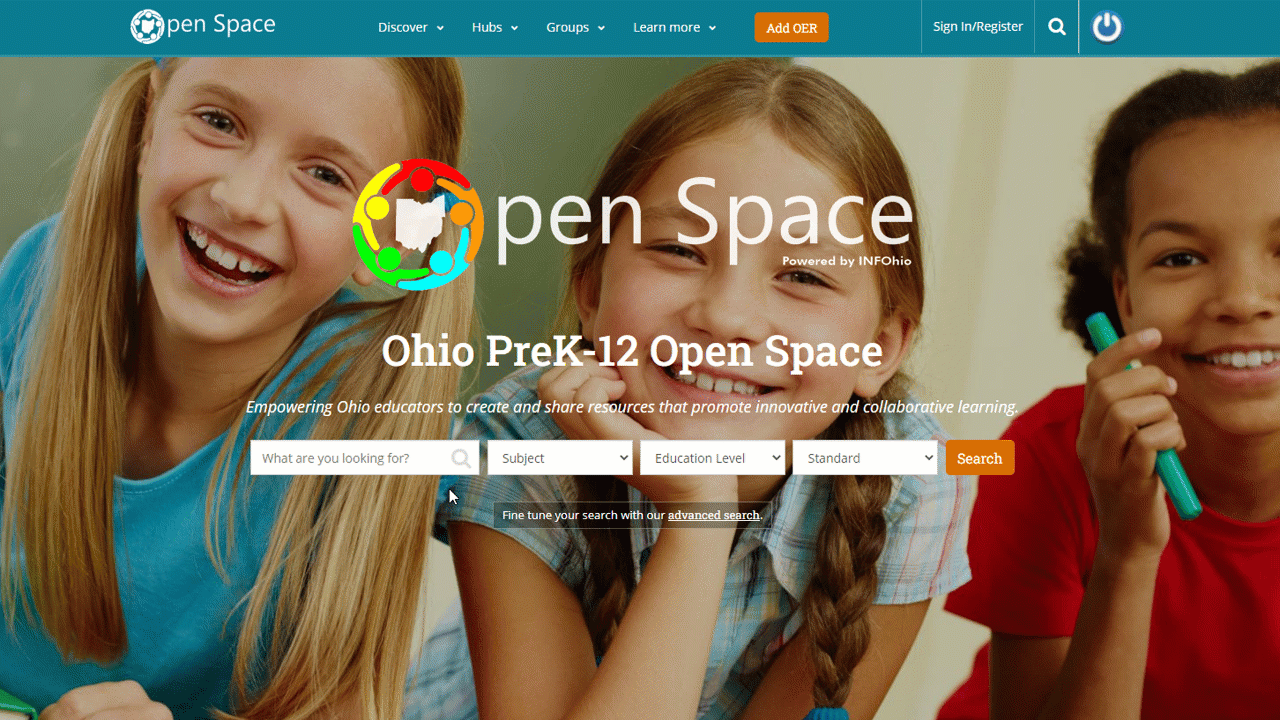By far the most useful functions to find instructional content on Open Space are search and filters, also known as limiters. These functions can be used in most areas of the platform, including the landing page, collections, hubs, and groups.
Perhaps the most easily understood concept in finding content is search. Type a few keywords that relate to what you'd like to find and press enter. For example, type "active passive" when looking for an activity related to active and passive voice. Open Space will look through all text data to find records related to your keywords, including titles, descriptions, tags, and other metadata.
Did you know? Clicking the Search button without any keywords will return all instructional materials. This allows users to apply filters so they can see everything for a given subject or grade level.
Filters, or limiters, can help narrow down search results to specific materials. Popular filters on Open Space include:
To help decide which options to use when filtering by Material Type, here is a description of each:
| Material Type | Description |
|---|---|
| Activity/Lab | Supplemental, student-facing resource requiring students to provide answers or feedback based on taking specified steps |
| Assessment | Student-facing question or prompt that measures understanding of a topic or idea |
| Homework/Assignment | A learner activity for acquiring certain skills, concepts, or knowledge, whether guided by an instructor or not |
| Student Guide | A student-facing supplement to a course that provides additional content and tutorial instruction for another course or topic |
| Syllabus | An outline of the contents and requirements of a course |
| Catalog | Organized collections of learning resources, often accompanied by a dedicated search platform or database, providing easy access to a large amount of content from a provider or about a subject area. |
| Full Course | A series of units and lessons used to teach the skills and knowledge required by the curriculum |
| Lecture | Recording or transcript of an educational speech |
| Lesson | Organize content within a course, and may cover one or more concepts or topics |
| Module | Organize content within a course and may cover one or more concepts or topics |
| Unit of Study | A plan of instruction on a particular concept, containing multiple lessons that are related |
| Bibliography | Includes curated lists of books, articles, and other resources, guiding learners to explore relevant and credible sources on a specific topic |
| Lesson Plan | A teacher-facing description of a course of instruction |
| Teaching/Learning Strategy | Method or strategy to achieve effective teaching and learning |
| Audio/Video | Includes podcasts, audio books, recorded webinars and lectures, and video tutorials and lessons |
| Diagram/Illustration | Visual media, including pictures, graphics, diagrams, figures, illustrations, charts, and maps |
| Game | A game designed with an educational purpose |
| Interactive | A visual tool in which students can move items around, enter variables, and/or answer questions |
| Simulation | Imitation of a physical process over time |
| Case Study | When actually occurring events or scenarios are used to illustrate scientific or academic principles |
| Data Set | A collection of related sets of data |
| Lecture Notes | Instructor-created notes to support student understanding of lectures |
| Primary Source | Original document or object created at the time of the period of time being studied, for example, newspaper article or government document |
| Reading | The body of a printed work, to include reading passages |
| Textbook | A book used in the study of an academic or scientific subject |
An 8th grade English Language Arts teachers wants to find a supplemental, interactive learning activity for students to practice forming and using verbs in the active and passive voice. This topic is covered in Ohio Learning Standards for ELA L.8.3a and L.8.1b. The teacher should enter the keywords active passive in the search box. After the initial results appear, the teacher can refine the search on the left side of the page by applying the following limiters:
The remaining results are now filtered to show only interactive items that are aligned to grade 8 ELA standards. Scan through the list of results to find the perfect supplement to your lesson. Then click on the title or image to explore the details of the resource.

Before continuing in this class, test Open Space's search and filters by looking for certain instructional materials. Then, reflect on the following questions:
Fetch is avaiable to INFOhio automated schools. If you are an INFOhio school, please log in with your school username/password using the button at the top-left corner of this page.
For more information about Fetch, please visit the Fetch information page or contact INFOhio support at https://support.infohio.org.